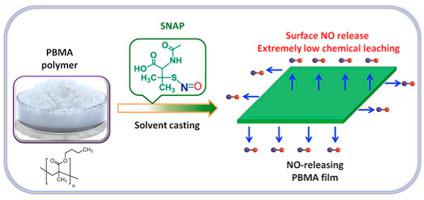Polymer ( IF 4.1 ) Pub Date : 2021-06-11 , DOI: 10.1016/j.polymer.2021.123943 Yang Zhou , Peixuan Wu , Jianfeng Wu , Joshua C. Doverspike , Qi Zhang , Jinyu Shao , Chuanwu Xi , Yuanyuan Liu , Mark E. Meyerhoff

|
Controllable delivery of nitric oxide (NO) platforms have attracted considerable attention for biomedical/therapeutic applications. Poly(n-butyl methacrylate) is one of the most widely explored biomedical materials as a primer and is used in manufacturing the commercial XIENCE family of coronary stents. Herein we report the preparation of NO-releasing poly(n-butyl methacrylate) (PBMA) films via incorporation of S-nitroso-N-acetylpenicillamine (SNAP) within, and explore the NO-releasing profiles of such films under physiological conditions. Specifically, the total NO-release time of PBMA films doped with SNAP can reach up to 75 d, and the total leaching of SNAP is extremely low (~2.2%, based on HPLC-MS measurements). The surface morphology of SNAP-doped PBMA films indicates the formation of needle-like crystalline SNAP particles, which is further confirmed by the PXRD data. Based on element mapping, SNAP is found to be homogenously distributed within the PBMA polymer phase. Moreover, the antimicrobial and anti-biofilm properties of the NO-releasing PBMA polymer films are demonstrated using E. coli, P. aeruginosa, S. aureus, and S. epidermidis bacterial strains over 7 d periods. These results suggest that the controllable release of NO using PBMA films could be useful for therapeutic or biomedical device applications. Moreover, the corresponding data would also contribute to the exploration of the controllable drug release property using PBMA as the polymer matrix during the manufacture of biomedical stents.
中文翻译:

用掺杂有S-亚硝基-N-乙酰青霉胺的聚(甲基丙烯酸正丁酯)薄膜输送一氧化氮
一氧化氮 (NO) 平台的可控递送在生物医学/治疗应用中引起了相当大的关注。聚(甲基丙烯酸正丁酯)是最广泛探索的生物医学材料之一,用作底漆,用于制造商用 XIENCE 冠状动脉支架系列。在此,我们报告了通过掺入S-亚硝基-N制备释放 NO 的聚(甲基丙烯酸正丁酯)(PBMA)薄膜-乙酰青霉胺 (SNAP),并探索生理条件下此类薄膜的 NO 释放曲线。具体而言,掺杂 SNAP 的 PBMA 薄膜的总 NO 释放时间可达 75 d,并且 SNAP 的总浸出率极低(~2.2%,基于 HPLC-MS 测量)。SNAP 掺杂的 PBMA 薄膜的表面形貌表明形成了针状结晶 SNAP 颗粒,PXRD 数据进一步证实了这一点。基于元素映射,发现 SNAP 均匀分布在 PBMA 聚合物相中。此外,使用大肠杆菌、铜绿假单胞菌、金黄色葡萄球菌和表皮葡萄球菌证明了释放 NO 的 PBMA 聚合物膜的抗菌和抗生物膜特性超过 7 天的细菌菌株。这些结果表明,使用 PBMA 薄膜可控地释放 NO 可用于治疗或生物医学设备应用。此外,相应的数据也将有助于探索在生物医学支架制造过程中使用 PBMA 作为聚合物基质的可控药物释放特性。















































 京公网安备 11010802027423号
京公网安备 11010802027423号